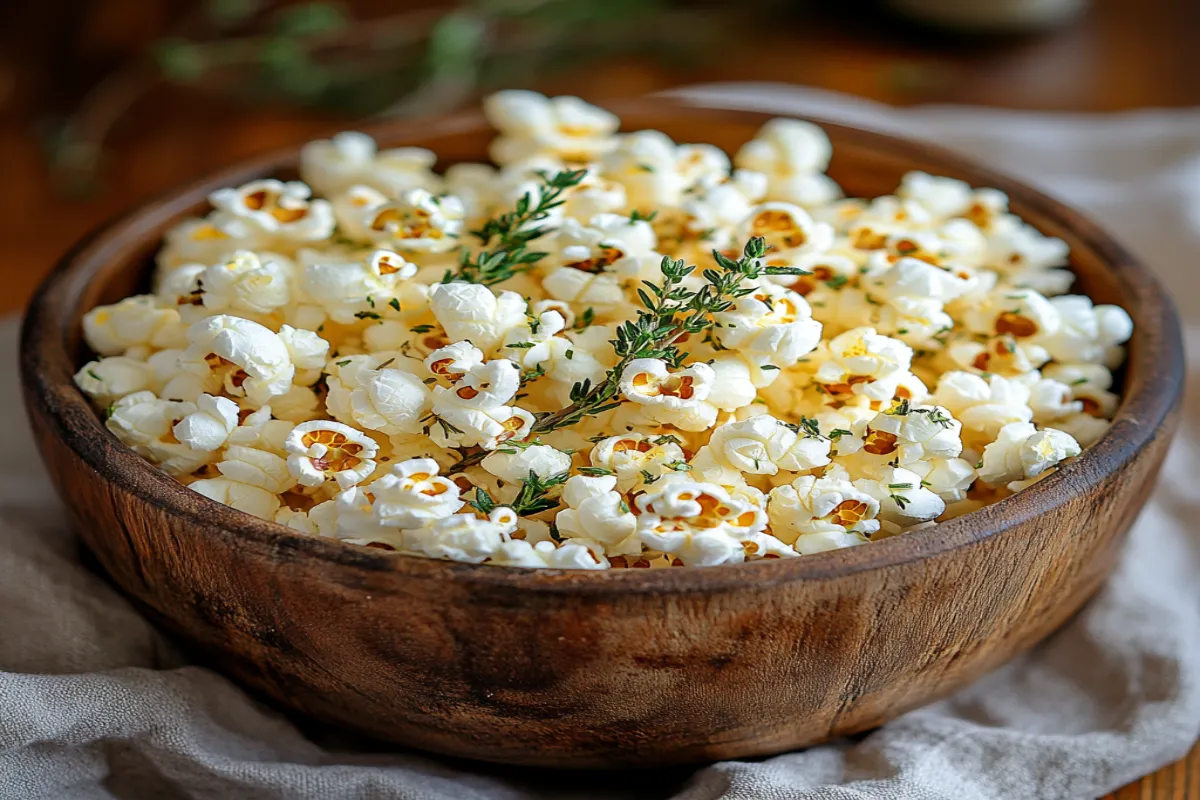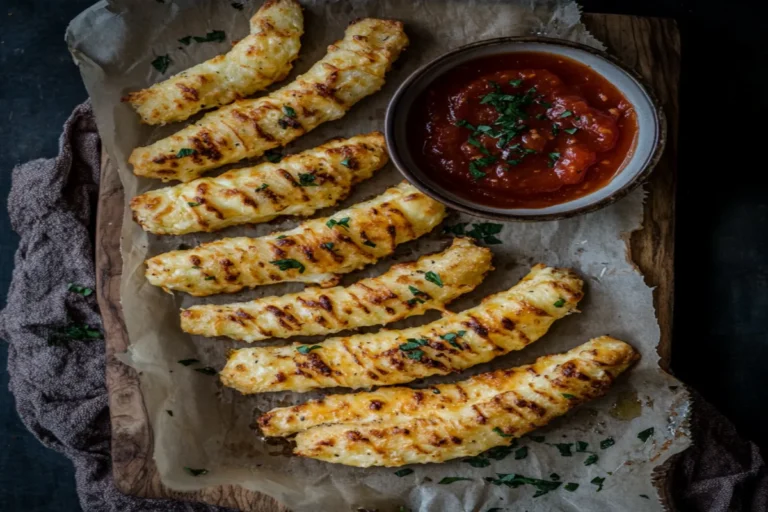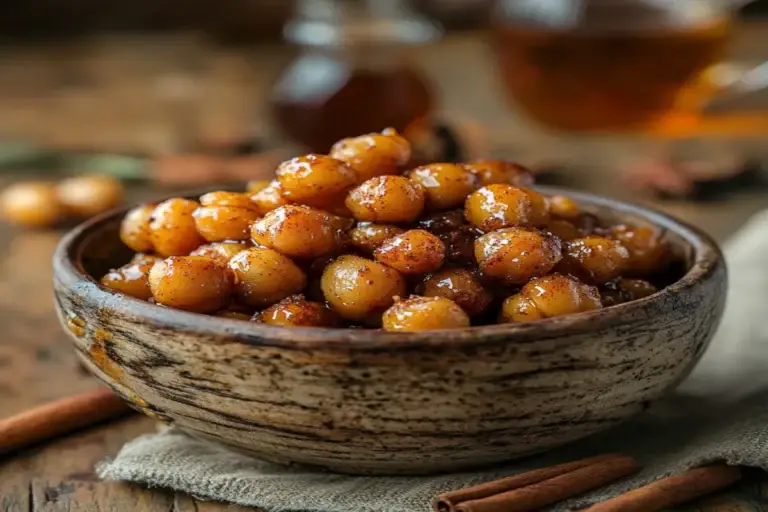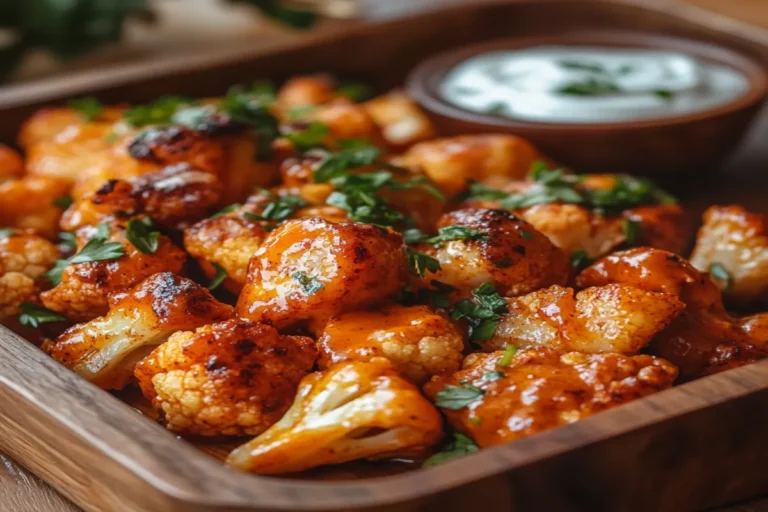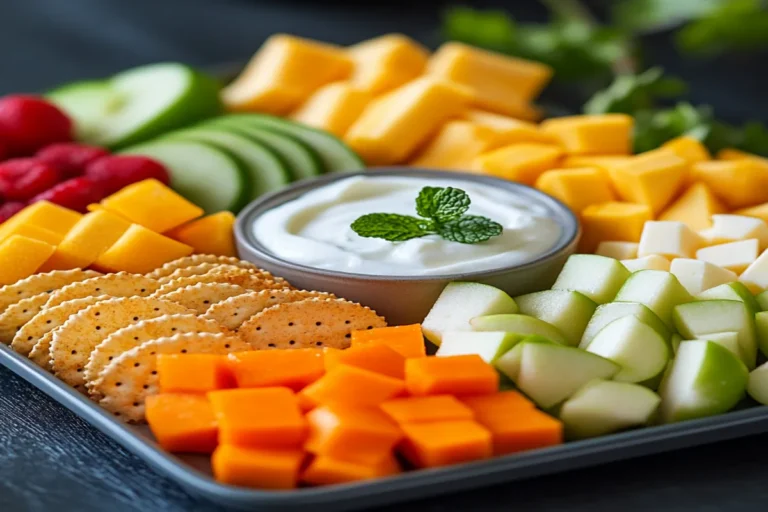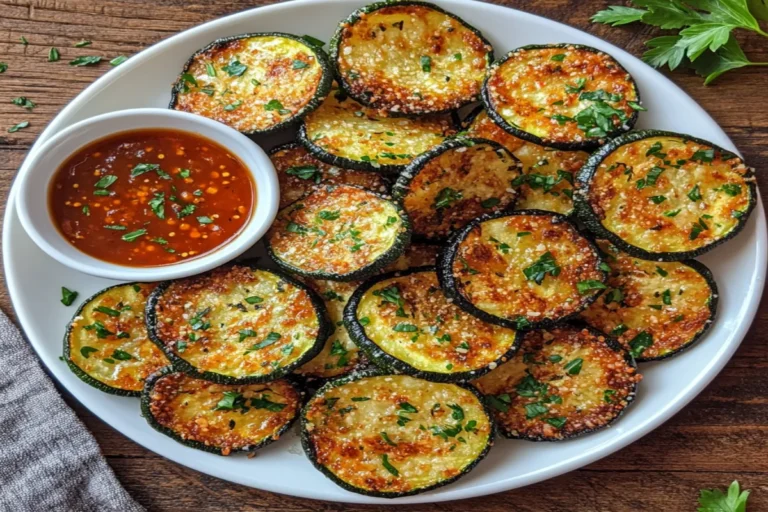Easy Herb Popcorn Snack Recipe with Olive Oil and Sea Salt
In a world where snacking often means reaching for processed packages filled with unpronounceable ingredients, there’s something profoundly satisfying about transforming the humble popcorn kernel into an elevated culinary experience. By incorporating fresh herbs, quality olive oil, and mineral-rich sea salt, we can create a snack that’s both sophisticated and wholesome—proving that healthy eating doesn’t require sacrificing flavor or enjoyment.
My journey with herbed popcorn began during a particularly stressful work period when I found myself mindlessly consuming bag after bag of artificial cheese-dusted popcorn. The guilt from both the nutritional emptiness and excessive sodium finally drove me to experiment with homemade alternatives. That first batch—simple popcorn tossed with rosemary-infused olive oil and coarse sea salt—was nothing short of revelatory. The herbs added complexity and freshness, while the quality oil provided richness without heaviness. Most importantly, I felt satisfied after eating it rather than compelled to continue mindlessly munching.
What makes herbed popcorn particularly appealing is its beautiful simplicity combined with endless customization possibilities. With just four basic components—popcorn kernels, extra virgin olive oil, sea salt, and fresh or dried herbs—you can create dozens of flavor combinations that rival any gourmet snack while knowing exactly what you’re putting into your body. This recipe represents the perfect intersection of convenience, health consciousness, and genuine flavor satisfaction.
Table of Contents
The Appeal of Homemade Herb Popcorn
Creating herbed popcorn at home offers significant advantages over commercial alternatives, beginning with complete control over ingredients and portion sizes. Store-bought flavored popcorns often contain artificial flavors, excessive sodium, preservatives, and unhealthy oils that contribute little beyond shelf stability. When you pop your own kernels and season them thoughtfully, you eliminate these unnecessary additives while creating a snack that’s genuinely nourishing.
From a health perspective, plain popcorn is remarkably wholesome. It’s a whole grain that provides fiber, antioxidants, and several essential minerals while remaining naturally low in calories. Three cups of air-popped popcorn contain only about 90 calories while providing nearly 4 grams of fiber—making it an exceptionally satisfying snack that supports digestive health and helps maintain stable blood sugar levels. When enhanced with extra virgin olive oil, you add healthy monounsaturated fats that support heart health and help with the absorption of fat-soluble vitamins.
The flavor customization possibilities with herbs are virtually limitless, allowing you to create snacks that complement different moods, seasons, or occasions. Mediterranean herb blends transport you to sun-soaked hillsides, while warming winter herbs like sage and thyme create comfort food satisfaction without heaviness. This flexibility means you’ll never grow bored with your snacking routine, and you can adapt flavors to complement specific meals or seasonal ingredients.
Perhaps most importantly, herbed popcorn bridges the gap between healthy eating and genuine satisfaction. Unlike many “healthy snacks” that leave you feeling virtuous but unsatisfied, well-seasoned herbed popcorn provides the complex flavors and textural satisfaction that make snacking truly enjoyable. The combination of savory herbs, quality oil, and sea salt creates a flavor profile that’s both sophisticated and comforting—perfect for solo snacking or entertaining guests.
This versatility extends to various occasions and settings. Light, herb-forward versions work beautifully as appetizers for dinner parties, while heartier combinations satisfy movie night cravings. The snack travels well, making it perfect for work lunches, hiking trips, or afternoon pick-me-ups that won’t derail your energy levels.
Ingredient Spotlight
The success of exceptional herbed popcorn depends entirely on the quality and characteristics of its four simple components, each contributing essential elements to the final flavor and texture profile.
Popcorn Kernels form the foundation of this snack, and understanding different varieties enhances your results significantly. Yellow kernels are the most common variety, offering reliable popping performance and mild corn flavor that accepts seasonings well. White kernels tend to be slightly more tender with a subtly sweet flavor that some prefer for delicate herb combinations. Both varieties work excellently for herbed applications.
The popping method significantly impacts the final texture and health profile. Air-popping creates the lightest, crispiest results while adding zero fat, making it ideal for those monitoring caloric intake or preferring to control fat content entirely through added oil. Stovetop popping in a heavy-bottomed pot with minimal oil creates slightly richer flavor while still maintaining control over ingredients. Avoid microwave bags, even “plain” varieties, as they often contain questionable additives and oils that interfere with delicate herb flavors.
Extra Virgin Olive Oil serves multiple crucial functions beyond simply carrying flavors. Its monounsaturated fat content supports heart health while providing essential fatty acids that aid nutrient absorption. From a culinary perspective, quality extra virgin olive oil contributes its own complex flavor notes—from peppery and robust to mild and buttery—that complement herb seasonings beautifully.
When selecting olive oil for this application, choose bottles labeled “extra virgin” that specify harvest dates and origin. Fresher oils (ideally within 18 months of harvest) provide better flavor and nutritional benefits. For herb popcorn, medium-intensity oils work best—robust enough to contribute flavor but not so strong as to overpower delicate herbs. Store olive oil in a cool, dark place to preserve its quality and flavor compounds.
Sea Salt elevates this snack far beyond what table salt can achieve. Unlike refined table salt, which is primarily sodium chloride, sea salt retains trace minerals from its ocean origins that contribute subtle complexity to the overall flavor profile. The crystal structure of sea salt also affects how it adheres to and dissolves on the popcorn, creating more interesting textural experiences.
Different sea salts offer varying intensities and mineral profiles. Fine sea salt distributes more evenly and dissolves quickly, while coarser varieties provide bursts of salinity and textural interest. Gray sea salt offers more mineral complexity, while flaky sea salts like Maldon provide delicate crunch and clean flavor. For herbed popcorn, fine to medium sea salt typically works best for even distribution.
Herbs transform simple popcorn into a gourmet snacking experience, with each variety contributing distinct aromatic and flavor qualities. Rosemary offers piney, slightly resinous notes that pair beautifully with olive oil, creating a distinctly Mediterranean character. Thyme provides earthy, slightly minty qualities that complement both delicate and robust flavor profiles. Oregano contributes bright, almost citrusy notes with subtle heat, while basil adds sweet, peppery complexity.
Fresh herbs generally provide brighter, more complex flavors, while dried herbs offer concentrated intensity and longer shelf life. Both have their place in herbed popcorn applications, often depending on availability, desired intensity, and preparation method. Understanding how to properly prepare each type maximizes their flavor contribution to the finished snack.
Selecting and Preparing Herbs
The choice between fresh and dried herbs significantly impacts both flavor development and preparation technique, making it essential to understand the strengths and optimal applications of each form.
Fresh herbs offer vibrant, complex flavor profiles with subtle nuances that dried versions cannot match. They provide bright, aromatic qualities that feel particularly appropriate for lighter, more refined snacking experiences. Fresh herbs work exceptionally well when you want the herb flavor to feel bright and garden-fresh rather than concentrated and earthy. Varieties like basil, cilantro, and parsley lose significant character when dried, making fresh versions strongly preferable for these particular herbs.
However, fresh herbs require more careful handling and preparation to achieve optimal results with popcorn. They contain moisture that can make popcorn soggy if not properly managed, and their delicate oils can dissipate quickly if overheated. Fresh herbs work best when added after the popcorn has cooled slightly, allowing their aromatic compounds to perfume the snack without being damaged by excessive heat.
Dried herbs provide concentrated flavor intensity and practical advantages that often make them preferable for popcorn applications. They lack the moisture content that can compromise popcorn’s crispness, and their concentrated flavor oils distribute more evenly throughout the snack. Dried herbs also offer better storage stability and availability, making them more practical for regular snacking routines.
The key to maximizing dried herb flavor lies in proper reactivation. Crushing dried herbs between your fingers or using a mortar and pestle releases essential oils that have been dormant, significantly improving their flavor contribution. This technique, called “blooming,” awakens the herb’s aromatic compounds and ensures they’ll distribute effectively throughout the popcorn.
Preparation techniques vary depending on the herb form and desired intensity. For fresh herbs, gentle chopping releases oils without bruising delicate leaves, while more robust herbs like rosemary benefit from finer mincing to distribute their stronger flavors evenly. Some herbs, particularly woody varieties like rosemary and thyme, benefit from brief toasting in a dry pan before adding to popcorn, which intensifies their flavors and creates more complex aromatic profiles.
Oil infusion represents perhaps the most effective method for incorporating herb flavors into popcorn. Gently warming olive oil with fresh or dried herbs allows the fat to extract and concentrate the herbs’ essential oils, creating a flavored oil that distributes evenly throughout the popcorn while providing consistent flavor in every bite. This technique works particularly well with robust herbs like rosemary, oregano, and thyme.
Storage considerations ensure your herbs maintain maximum flavor potential. Fresh herbs should be stored properly to maintain their vitality—tender herbs like basil and cilantro benefit from being stored like flowers in water, while heartier varieties like rosemary and thyme can be wrapped in damp paper towels and refrigerated. Dried herbs maintain quality longest when stored in airtight containers away from light and heat, and should generally be replaced annually for optimal flavor.
Step-by-Step Preparation Guide
Creating perfect herbed popcorn requires attention to timing and technique, but the actual process remains refreshingly simple and quick—typically requiring only 10-15 minutes from start to finish.
Popping the Corn
forms the foundation of exceptional herbed popcorn, and proper technique ensures optimal texture and flavor reception. For stovetop popping, heat 2 tablespoons of neutral oil (like avocado or grapeseed) in a heavy-bottomed pot over medium-high heat. Add 3-4 test kernels and cover the pot. When these kernels pop, remove them and add ½ cup of popcorn kernels in a single layer. Cover and shake the pot gently to distribute kernels evenly.
As popping begins, shake the pot every 10-15 seconds to prevent burning and ensure even heating. The popping will start slowly, then accelerate rapidly before tapering off. When you hear only occasional pops (about 2-3 seconds between pops), remove the pot from heat but keep it covered for another 30 seconds to allow any remaining kernels to finish popping. This technique should yield approximately 8-10 cups of perfectly popped corn.
For air-popping, follow your machine’s instructions, which typically involve adding kernels to the chamber and allowing the hot air circulation to pop them without any added oil. This method produces the lightest results and allows for complete control over fat content through the seasoning process.
Infusing the Olive Oil
creates the flavor foundation that transforms plain popcorn into an aromatic delicacy. In a small saucepan, gently warm 3-4 tablespoons of extra virgin olive oil over low heat. Add your chosen herbs—approximately 1 tablespoon of fresh chopped herbs or 1 teaspoon of dried herbs per batch of popcorn. The goal is gentle warming, not cooking, which preserves delicate flavor compounds while extracting essential oils into the fat.
Allow the oil to warm with the herbs for 2-3 minutes, swirling occasionally to distribute heat evenly. You should notice the herbs becoming more aromatic as their oils release into the oil. For dried herbs, you might hear gentle sizzling, which indicates proper extraction. Remove from heat and allow to steep for another 2-3 minutes, which continues the flavor development process without risking overheating.
Strain the infused oil through a fine-mesh sieve if you prefer smooth oil without herb particles, or leave the herbs in the oil for more intense flavor and visual interest. Both approaches work well, depending on your texture preferences and the specific herbs used.
Combining Ingredients
requires technique to ensure even distribution without compromising the popcorn’s crispness. Transfer the hot popcorn to a large bowl, allowing it to cool for 1-2 minutes. This brief cooling prevents the oil from being absorbed too quickly, which could create soggy spots.
Drizzle the infused oil over the popcorn gradually while tossing continuously with clean hands or a large spoon. Start with about half the oil, toss thoroughly, then add the remainder as needed. The goal is light, even coating rather than saturation. Every kernel should glisten slightly but not feel greasy.
Add sea salt gradually while continuing to toss, starting with ½ teaspoon and adjusting to taste. The salt should distribute evenly throughout the batch, and you can always add more but cannot remove excess. Taste and adjust both oil and salt levels as needed—the flavors should be balanced and harmonious rather than overpowering.
Serving Suggestions
maximize the snacking experience and presentation. Serve herbed popcorn immediately for optimal crispness and flavor intensity. For casual snacking, serve in large bowls with napkins nearby, as the oil will make fingers slightly greasy. For entertaining, consider serving in small individual bowls or paper cones for easy handling and portion control.
Portion sizes typically range from 2-3 cups per serving for light snacking to 4-5 cups for heartier appetites or meal replacement scenarios. The herb-infused oil provides satisfying richness that makes smaller portions more satisfying than plain popcorn, helping with portion control naturally.
Tips for Perfect Herb Popcorn
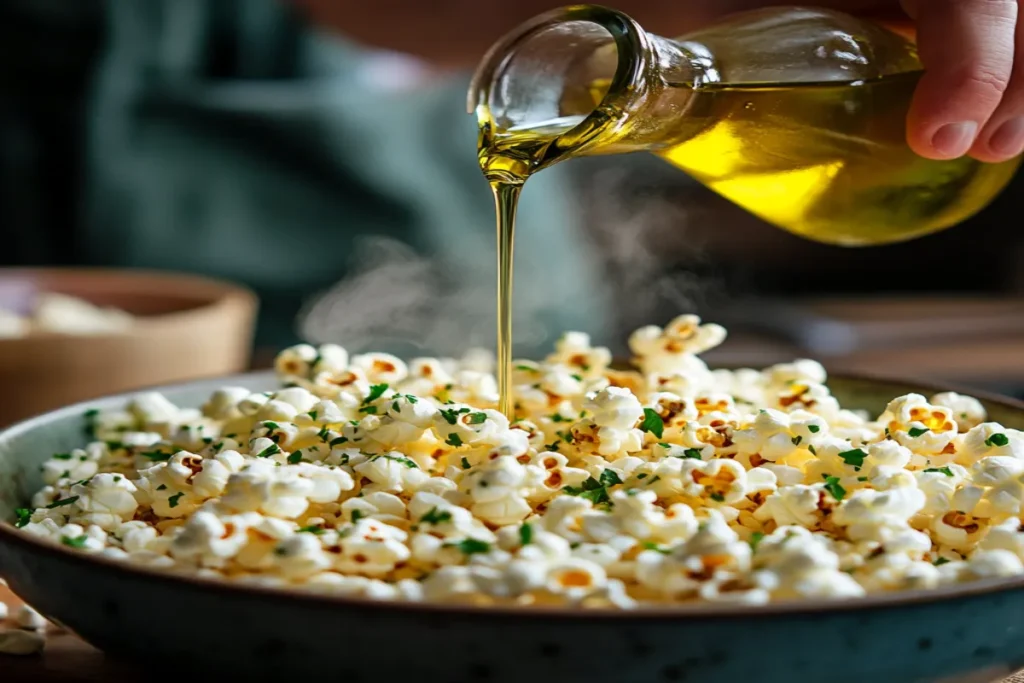
Achieving consistently excellent herbed popcorn requires understanding several key principles that separate good results from exceptional ones.
Avoiding Sogginess represents the most critical challenge when adding oil to popcorn. The key lies in controlling temperature, timing, and technique throughout the process. Allow freshly popped corn to cool for 1-2 minutes before adding oil, which prevents the oil from being absorbed too rapidly into the kernels. Hot popcorn acts like a sponge, quickly absorbing oil and losing its desirable crispness.
Use the minimum amount of oil necessary to carry the herb flavors and provide light coating. Typically, 3-4 tablespoons of infused oil suffices for a full batch of popcorn (8-10 cups). More oil doesn’t necessarily mean better flavor—it often results in soggy, greasy popcorn that loses its textural appeal.
Add oil gradually while tossing continuously, which ensures even distribution without overwhelming any particular area. Pour the oil in a thin stream while moving around the bowl rather than dumping it in one spot. This technique creates more consistent coating and prevents oil pooling.
Even Flavor Distribution requires systematic approach and proper tools. Use a bowl large enough to allow vigorous tossing without spillage—the bowl should be at least twice the volume of your popped corn. Clean hands often work better than spoons for tossing, as they can feel the oil distribution and identify areas that might need attention.
Toss from the bottom up, lifting and turning the popcorn to ensure every kernel gets exposed to the seasoned oil. This process should be thorough and rhythmic, similar to tossing a salad. Don’t rush this step—proper mixing takes 2-3 minutes of continuous tossing to achieve professional results.
For particularly even distribution, consider the “shake and toss” method: place seasoned popcorn in a large paper bag, fold the top closed, and shake vigorously for 30 seconds. This technique often achieves more even coating than hand-tossing alone, though it works best with finely ground seasonings.
Flavor Balance and Adjustment requires tasting throughout the process and understanding how flavors develop. Start with conservative amounts of herbs and salt, as you can always add more but cannot subtract excess. Herb flavors often intensify slightly as they sit with the oil, so initial under-seasoning can correct itself within 5-10 minutes.
Salt perception changes with oil content—more oil requires slightly more salt to achieve the same flavor impact. However, the herbs themselves often contain natural salts and minerals that contribute to overall salinity, so taste carefully before adding additional salt.
Consider the eating context when adjusting flavors. Popcorn served as a light appetizer might benefit from more delicate seasoning, while movie night snacking could handle more robust flavors. The beauty of homemade herbed popcorn lies in this customization capability.
Temperature Management throughout the process affects both texture and flavor development. Serve herbed popcorn at room temperature rather than hot, which allows flavors to meld while maintaining optimal texture. Very hot popcorn can taste differently than room temperature popcorn, so final seasoning adjustments should happen after cooling.
Store any leftovers in airtight containers to prevent staleness, though herbed popcorn is always best consumed within a few hours of preparation for optimal crispness.
Variations to Explore
The basic herbed popcorn formula serves as a foundation for countless creative variations that can transform this simple snack into exciting new experiences while maintaining its wholesome character.
Cheesy Herb Combinations add richness and umami depth that complement herbal notes beautifully. Finely grated Parmesan cheese, added after the oil but before final tossing, creates an Italian-inspired snack that pairs particularly well with rosemary, oregano, or basil. Use about 2-3 tablespoons of finely grated cheese per batch, adding it gradually while tossing to ensure even distribution.
For dairy-free options, nutritional yeast provides similar cheesy, nutty flavors while maintaining the vegan-friendly nature of the base recipe. Nutritional yeast offers the additional benefit of B-vitamins, particularly B12, making it nutritionally superior to traditional cheese. Use slightly more nutritional yeast than Parmesan—about ¼ cup per batch—as its flavor is milder but equally satisfying.
Hemp seeds create another interesting variation that adds protein, healthy fats, and subtle nutty flavor that complements most herb combinations. Sprinkle 2-3 tablespoons over the oiled popcorn before final tossing for added nutrition and textural interest.
Spicy Herb Variations introduce heat that creates more complex flavor profiles suitable for those who enjoy more adventurous snacking. Red pepper flakes work particularly well with Mediterranean herbs like oregano and basil, creating Italian-inspired heat levels. Start with ¼ teaspoon red pepper flakes per batch, as the heat intensifies over time.
Cayenne pepper provides cleaner heat without texture changes, making it ideal for maintaining the popcorn’s visual appeal while adding significant spice. Use sparingly—⅛ teaspoon per batch often suffices, and you can always add more to individual portions.
For more complex heat, consider adding smoked paprika along with herbs like thyme or rosemary. This combination creates southwestern flavor profiles that feel both warming and sophisticated. Smoked paprika also adds beautiful color that makes the popcorn visually appealing for entertaining.
Sweet and Savory Combinations create sophisticated flavor profiles that surprise and delight. A light drizzle of high-quality honey combined with rosemary and sea salt creates a complex snack that works beautifully as an appetizer or sophisticated movie night treat. Warm the honey slightly to help it distribute evenly, using about 1 tablespoon per batch.
Maple syrup paired with sage creates an autumn-inspired combination that feels both comforting and elegant. The earthiness of sage complements maple’s sweetness while the salt enhances both flavors. This combination works particularly well for seasonal entertaining or when you want something that feels special without being overly sweet.
Balsamic reduction adds sophisticated tanginess that pairs beautifully with basil or oregano. Prepare the reduction separately by simmering balsamic vinegar until it reaches syrup consistency, then drizzle lightly over the herbed popcorn. This combination creates a snack reminiscent of caprese salad flavors.
International Flavor Profiles draw inspiration from global cuisines to create unique snacking experiences. Za’atar, a Middle Eastern spice blend containing herbs, sesame seeds, and sumac, creates an instantly exotic flavor profile when tossed with olive oil and popcorn. The tanginess of sumac combined with the nuttiness of sesame creates complexity that rivals any gourmet snack.
Japanese-inspired versions might combine toasted sesame oil with nori flakes and sea salt for an umami-rich snack that feels both familiar and exotic. Chinese five-spice powder with a touch of sesame oil creates warming, aromatic combinations perfect for cooler weather.
Herbes de Provence creates French-inspired elegance that works beautifully for sophisticated entertaining. This blend typically contains lavender, rosemary, thyme, and other Mediterranean herbs that create complex, aromatic profiles perfect for wine tastings or dinner party appetizers.
Frequently Asked Questions
Can I use microwave popcorn as a base for this recipe?
While fresh-popped kernels always produce superior results, plain microwave popcorn can work in a pinch when convenience is essential. Choose brands labeled as “plain” or “natural” without added butter, cheese, or artificial flavors, as these interfere with the delicate herb seasonings you’re adding. Pop the microwave popcorn according to package directions, then transfer to a large bowl and proceed with the herb oil infusion as described. Keep in mind that microwave popcorn often contains more sodium than fresh-popped kernels, so reduce the added sea salt accordingly and taste carefully before final seasoning adjustments.
How long does herbed popcorn maintain its freshness and optimal texture?
Herbed popcorn tastes best when consumed within 2-4 hours of preparation, while the kernels maintain their crispness and the herb flavors remain bright and aromatic. For longer storage, transfer cooled popcorn to an airtight container where it will maintain acceptable quality for up to 2 days at room temperature. However, the oil will gradually soften the kernels, and the herb flavors will mellow over time. If storing overnight, you can refresh the texture slightly by spreading the popcorn on a baking sheet and warming it in a 250°F oven for 5-7 minutes, which helps restore some crispness. Avoid refrigerating herbed popcorn, as the moisture can make it soggy faster than room temperature storage.
Is this recipe suitable for various dietary restrictions?
Herbed popcorn with olive oil and sea salt is naturally vegan, gluten-free, and dairy-free, making it suitable for most dietary restrictions. For those following strict vegan diets, ensure that any additional seasonings (like nutritional yeast or specific herb blends) are certified vegan. The recipe is also compatible with paleo diets, keto diets (in moderation due to the carbohydrate content of corn), and most whole food approaches to eating. For those monitoring sodium intake, the sea salt can be reduced or eliminated entirely, as the herbs provide significant flavor on their own. Those with corn allergies obviously cannot enjoy this recipe, but the herb oil preparation technique works beautifully with other air-popped grains or seeds.
Can I prepare the herb-infused oil in advance?
Herb-infused olive oil can be prepared up to 24 hours in advance and stored in the refrigerator, which actually allows the flavors to develop more fully over time. Prepare the infused oil as directed, then store it in a small jar or container in the refrigerator. Before using, allow the oil to come to room temperature, or warm it gently in a small saucepan to return it to a pourable consistency—cold olive oil becomes thick and difficult to distribute evenly. For food safety, don’t store fresh herb-infused oils for more than a few days, as fresh herbs can introduce bacteria that multiply in oil. Dried herb infusions last longer but should still be used within a week for optimal flavor and safety.
Conclusion
Herbed popcorn with olive oil and sea salt represents far more than a simple snack—it’s a testament to how thoughtful ingredient selection and basic technique can transform everyday foods into something genuinely special. By choosing quality components and treating them with respect, we create snacking experiences that nourish both body and soul while satisfying our desire for flavors that feel sophisticated yet comforting.
This recipe embodies the principles of mindful eating: knowing exactly what goes into your food, choosing ingredients that contribute genuine nutritional value, and creating flavors complex enough to satisfy on multiple levels. Unlike processed snacks that leave you feeling empty despite being full, herbed popcorn provides sustained satisfaction through its combination of whole grains, healthy fats, and aromatic herbs that engage your senses completely.
The beauty of this preparation lies in its infinite adaptability. Whether you prefer Mediterranean herbs that transport you to sun-drenched hillsides or warming winter combinations that provide comfort during cold months, the basic technique remains the same while the results feel entirely different. This flexibility ensures you’ll never grow bored with healthy snacking, and you can adapt flavors to complement seasons, occasions, or simply your current mood.
What variations are you excited to try first? Have you experimented with herb combinations in other recipes that might translate beautifully to popcorn? We’d love to hear about your creative discoveries and favorite flavor combinations in the comments below. Your experiments might inspire other readers to try new combinations they hadn’t considered.
For more recipes that prove healthy eating is delicious eating, subscribe to our newsletter. Each week, we share new ideas for transforming simple ingredients into extraordinary experiences, from energizing breakfasts to satisfying dinners and everything in between. Join our community of food enthusiasts committed to exploring how mindful cooking can enhance both health and happiness.
What herb combination will you try first for your own elevated popcorn experience?

